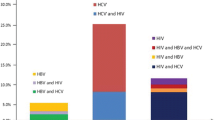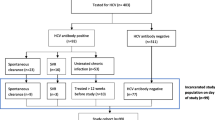Abstract
Background:
Hepatitis C virus (HCV) remains very prevalent in injection drug users (IDUs). In spite of recommended vaccinations against hepatitis A virus (HAV) and hepatitis B virus (HBV), many IDUs remain susceptible to HAV and HBV.
Study population and methods:
Patients entering heroin-assisted treatment between 2000 and 2002 (N = 210) were compared for infectious disease status with patients entering this treatment in 1998 (N = 243) and between 1994 and 1996 (N = 1035). Infection status was determined with the aid of questionnaires and blood tests for antibodies against HAV, HBV core antigen, HCV and HIV.
Results:
In the cohort 2000–2002 78.3% of the patients were HCV positive, 53.3% were HBV positive, 41.2% were HAV positive and 12.6% were HIV positive. In comparison to the cohorts entering the heroin- assisted treatment at an earlier time, there was a significant reduction of HBV and HAV infections, but not of HCV and HIV infections. 15.6% of the patients entering between 2000 and 2002 were vaccinated against HBV and 10.3% against HAV. 31.1% of patients at entrance were susceptible for HBV and 48.5% for HAV. In comparison to patients entering treatment in 1998 there was no significant increase in patients who were vaccinated against HBV.
Conclusions:
This data illustrates the need for improving HCV prevention and more consequent vaccination against HBV and HAV in IDUs.
Similar content being viewed by others
Abbreviations
- anti-HAV:
-
antibodies against HAV
- anti-HBc:
-
antibodies against HBV core antigen
- anti-HBs:
-
antibodies against HBV surface antigen
- anti-HCV:
-
antibodies against HCV
- anti-HIV:
-
antibodies against HIV
- HAT:
-
heroin- assisted treatment
- HAV:
-
hepatitis A virus
- HBV:
-
hepatitis B virus
- HCV:
-
hepatitis C virus
- HIV:
-
human immunodeficiency virus
- IDU:
-
injection drug user
References
Alter MJ, 2002; Prevention of spread of hepatitis C Hepatology 36: S 93–S98
Schreier E, Höhne M, 2001; Hepatitis C – Epidemiologie und Prävention Bundesgesundheitsblatt-Gesundheitsforschung-Gesundheitsschutz 6: 554–561
Grob PJ, Negro F, Renner EL, 2000; im Namen der Schweizer Experten für Virale Hepatitiden (SEVHEP) Hepatitis C-Virus-Infektion. übersicht. Praxis 89: 1587–1604
Dore GJ, Law M, MacDonald M, Kaldor JM, 2003; Epidemiology of hepatitis C virus infection in Australia J Clinical Virol 26: 171–184
Mathei C, Buntinx F, Van Damme P, 2002; Seroprevalence of hepatitis C markers among intravenous drug users in western European countries: A systematic review J Viral Hepat 9: 157–173
Backmund M, Meyer K, Wächtler M, Eichenlaub D, 2003; Hepatitis C virus infection in injection drug users in Bavaria: Risk factors for seropositivity Eur J Epidemio 18: 563–568
Steffen T, Christen S, Blättler R, Gutzwiller F und das PROVE Team. Infectious diseases and public health: Risk-taking behavior during participating in the Swiss programme for a medical prescription of narcotics (PROVE). Substance Use & Misuse 2001; 36(1&2): 72–89
Blättler R, Kaufmann B, Nieuwenboom W, Gschwend P, Steffen T, Uchtenhagen A, 2000; Die medizinische und soziale Betreuung in der Heroingestützten Behandlung Schlussbericht des Instituts für Suchtforschung Zürich
Broers B, Junet C, Bourquin M, Déglon JJ, Perrin L, Hirschel B, 1998; Prevalence and incidence rate of HIV, hepatitits B and C among drug users on methadone maintenance treatment in Geneva between 1988 and 1995 AIDS 12: 2059–2066
Holbach M, Frösner GG, Donnerbauer E, Dittmeier E, Holbach B, 1998; Prävalenz von hepatitismarkern der typen A, B, C und assoziiertes risikoverhalten unter patienten nach intravenösem drogenkonsum Sucht 44(6): 390–398
Stark K, Bienzle U, Vonk R, Guggenmoos-Holzmann I, 1997; History of syringe sharing in prison and risk of hepatitis B virus, hepatitis C virus, and human immunodeficiency virus infection among injecting drug users in Berlin Int J Epidemiol 26(6): 1359–1366
Fehlauer F, Koops A, Lockmann F, et al. 1999; Prävalenz von Hepatitis B, Hepatitis C und HIV-Infektionen bei Drogentodesfällen in Hamburg (1985–1997) unter Berücksichtigung von epidemiologischen, forensischen und morphologischen Aspekten Rechtsmedizin 9: 205–209
Hope VD, Judd A, Hickman M, et al., 2001; Prevalence of hepatitis C among injecting drug users in England and Wales: Is harm reduction working? Am J Public Health 91(1): 38–42
Månsson AS, Moestrup T, Nordenfelt E, Widell A, 2000; Continued transmission of hepatitis B and C viruses, but no transmission of human immunodeficiency virus among intravenous drug users participating in a syringe/needle exchange program Scand J Infect Dis 32: 253–258
Uchtenhagen A, Dobler-Mikola A, Steffen T, Gutzwiller F, Blättler R, Pfeifer S, 2000; Betäubungsmittelverschreibung an Heroinabhängige Wichtigste Resultate der Schweizerischen Kohortenstudie Basel; Karger
Ochnio JJ, Patrick D, Ho M, Talling DN, Dobsen SR, 2001; Past infection with hepatitis A virus among Vancouver street youth, injecting drug users and men who have sex with men: implications for vaccinating programs The Can Med Assoc J 165(3): 293–300
Villano SA, Nelson KE, Vlahoy D, Purcell RH, Saah AJ, Thomas DL, 1997; Hepatitis A among homosexual men and injection drug users: More evidence for vaccination Clin Infect Dis 25(3): 726–728
Baumann C, 1999; Prävention und Intervention von Infektionskrankheiten in der heroingestützten Behandlung [Dissertation] Medizinische Fakultät der Universität Zürich Zürich, Schweiz 62 pp
Cook PA, Mc Veigh J, Syed Q, Mutton K, Bellis M, 2001; Predictors of hepatitis B and C infection in injecting drug users both in and out of drug treatment Addiction 96: 1787–1797
Lamagni TL, Hope VD, Davison KL, Parry JV, Gill ON, 2001; Failure to vaccinate current injecting drug users against hepatitis B in England and Wales Commun Dis Public Health 4(1): 71–72
BAG (Bundesamt für Gesundheit). Empfehlungen zur Hepatitis-B-Impfung. Ergänzung zum Supplementum II vom Dezember 1997. Bulletin 36 vom 31.08.1998. Bern: 1998
BAG (Bundesamt für Gesundheit). Empfehlungen zur kombinierten Hepatitis-A-und Hepatitis-B-Impfung. Bulletin 3 vom 27.01.1997. Bern: 1997
EMCDDA (European Monitoring Centres for Drug and Drug Addiction. 2004 Jahresbericht über den Stand der Drogenproblematik in der EU und in Norwegen. URL: http:// annualreport.emcdda.eu.int/download/ar2004-de.pdf, Lisboa: 2004
Crowcroft NS, 2003; Hepatitis A virus infections in injecting drug users Commun Dis Public Health 6(2): 82–84
RKI (Robert-Koch-Institut) (2001). Merkblätter für ärzte. Hepatitis A (aktualisiert). URL: http://www.rki.de/cln_011/ nn_225576/DE/Content/Infekt/EpidBull/Merkblaetter/Rat__HepatitisA, Berlin: Download date 2. August 2005
Grinde B, Stene-Johansen K, Sharma B, Hoel T, Jensenius M, Skaug K, 1997; Characterisation of an epidemic of hepatitis A virus involving intravenous drug abusers – infection by needle sharing? J Med Virol 53: 69–75
Roy K, Howie H, Parry J, Molyneaux P, Goldberg D, Taylor A, 2004; Hepatitis A virus and injecting drug misuse in Aberdeen, Scotland: A case–control study J Viral Hepat 11: 277–282
BAG (Bundesamt für Gesundheit) (2004). Hepatitis-A-Fälle im Zusammenhang mit Konsumenten von injizierbaren Drogen? Bulletin 6 vom 2. Februar 2004. Bern: 2004
UNAIDS. 2004 Report on the global AIDS epidemic. URL: http://www.unaids.org/bangkok2004/GAR2004_ html/GAR2004_00_en.htm, Geneva: 2004. Downlaod date: 2. August 2005
Schaaf S; Grichting E; Bolliger H, 2005; Der Forschungsverbund stationäre Suchttherapie act-info FOS im Jahr 2004 Forschungsbericht aus dem Institut für Suchtforschung Nr. 196 Zürich
Hope VD, Judd A, Hickman M, et al., 2001; Prevalence of hepatitis C among injection drug users in England and Wales: is harm reduction working? Am J Public Health 91(1): 38–42
Vidal-Trecan G, Varescon-Pousson I, Boissonnas A, 2002; Injection risk behaviors at the first and at the most recent injections among drug users Drug Alcohol Depend 66: 197–109
Garfein RS, Doherty MC, Monterroso ER, Thomas DL, Nelson KE, Vlahov D, 1998; Prevalence and Incidence of Hepatitis C Virus Infection Among Young Adult Injection Drug Users J Acquir Immune Defic Syndr Hum Retrovirol 18(Suppl. 1): S11–S19
Diaz T, Des Jarlais DC, Vlahov D, et al., 2001; Factors associated with prevalent hepatitis C: Differences among young adult injection drug users in lower and upper Manhatten, New York City Am J Public Health 91(1): 23–30
Acknowledgements
The authors thank the health professionals and patients of the treatment centers for providing the data for this study. We also want to thank Dr. Mirjam Kretzschmar for helpful discussions. The monitoring system for the heroin-assisted treatment is supported by the Swiss Federal Office of Public Health (Grant Nr. 00.000041/8155).
Author information
Authors and Affiliations
Corresponding author
Rights and permissions
About this article
Cite this article
Gerlich, M., Gschwend, P., Uchtenhagen, A. et al. Prevalence of hepatitis and HIV infections and vaccination rates in patients entering the heroin-assisted treatment in Switzerland between 1994 and 2002. Eur J Epidemiol 21, 545–549 (2006). https://doi.org/10.1007/s10654-006-9023-z
Accepted:
Published:
Issue Date:
DOI: https://doi.org/10.1007/s10654-006-9023-z




